
List of Russian architects
Encyclopedia
This is a list of architect
s of the Russian Federation, Soviet Union
, Russian Empire
, Tsardom of Russia
and Grand Duchy of Moscow
, both ethnic Russians
and people of other ethnicities. This list also includes those who were born in the Russia/
Russia/ Soviet Union/
Soviet Union/ Russian Empire/Tsardom of Russia
Russian Empire/Tsardom of Russia
/Grand Duchy of Moscow
but later emigrated, and those who were born elsewhere but immigrated to the country and/or worked there for a significant period of time.
Attested biographies of architect
s in Russian history
date back to 1475, when Aristotile Fioravanti
, a native of Bologna
, arrived in Moscow
to build the Dormition Cathedral of the Moscow Kremlin
. Foreign architects had a notable place in Russian and Soviet
history, especially in the last quarter of 18th century (Charles Cameron
, Bartolomeo Rastrelli
, Carlo Rossi
and others) and in the first quarter of the 20th century (Mies van der Roe
, Erich Mendelsohn
, Ernst May
and others). This list includes foreign architects whose primary, and most tangible work materialized on Russian soil (i.e. Cameron, Rastrelli, Rossi) while short-term assignments by visiting architects (Mies van der Roe, Mendelsohn, May) are omitted.
For the full plain list of Russian architects on Wikipedia, see :Category:Russian architects.
See also: Russian architecture
, List of Russian artists, List of Russian explorers, List of Russian inventors, List of Russian language writers, Russian culture
Architect
An architect is a person trained in the planning, design and oversight of the construction of buildings. To practice architecture means to offer or render services in connection with the design and construction of a building, or group of buildings and the space within the site surrounding the...
s of the Russian Federation, Soviet Union
Soviet Union
The Soviet Union , officially the Union of Soviet Socialist Republics , was a constitutionally socialist state that existed in Eurasia between 1922 and 1991....
, Russian Empire
Russian Empire
The Russian Empire was a state that existed from 1721 until the Russian Revolution of 1917. It was the successor to the Tsardom of Russia and the predecessor of the Soviet Union...
, Tsardom of Russia
Tsardom of Russia
The Tsardom of Russia was the name of the centralized Russian state from Ivan IV's assumption of the title of Tsar in 1547 till Peter the Great's foundation of the Russian Empire in 1721.From 1550 to 1700, Russia grew 35,000 km2 a year...
and Grand Duchy of Moscow
Grand Duchy of Moscow
The Grand Duchy of Moscow or Grand Principality of Moscow, also known in English simply as Muscovy , was a late medieval Rus' principality centered on Moscow, and the predecessor state of the early modern Tsardom of Russia....
, both ethnic Russians
Russians
The Russian people are an East Slavic ethnic group native to Russia, speaking the Russian language and primarily living in Russia and neighboring countries....
and people of other ethnicities. This list also includes those who were born in the
 Russia/
Russia/ Soviet Union/
Soviet Union/ Russian Empire/Tsardom of Russia
Russian Empire/Tsardom of RussiaTsardom of Russia
The Tsardom of Russia was the name of the centralized Russian state from Ivan IV's assumption of the title of Tsar in 1547 till Peter the Great's foundation of the Russian Empire in 1721.From 1550 to 1700, Russia grew 35,000 km2 a year...
/Grand Duchy of Moscow
Grand Duchy of Moscow
The Grand Duchy of Moscow or Grand Principality of Moscow, also known in English simply as Muscovy , was a late medieval Rus' principality centered on Moscow, and the predecessor state of the early modern Tsardom of Russia....
but later emigrated, and those who were born elsewhere but immigrated to the country and/or worked there for a significant period of time.
Attested biographies of architect
Architect
An architect is a person trained in the planning, design and oversight of the construction of buildings. To practice architecture means to offer or render services in connection with the design and construction of a building, or group of buildings and the space within the site surrounding the...
s in Russian history
History of Russia
The history of Russia begins with that of the Eastern Slavs and the Finno-Ugric peoples. The state of Garðaríki , which was centered in Novgorod and included the entire areas inhabited by Ilmen Slavs, Veps and Votes, was established by the Varangian chieftain Rurik in 862...
date back to 1475, when Aristotile Fioravanti
Aristotile Fioravanti
Ridolfo "Aristotele" Fioravanti was an Italian Renaissance architect and engineer. His surname is sometimes given as Fieraventi. Russian versions of his name are Фиораванти, Фьораванти, Фиеравенти, Фиораванте....
, a native of Bologna
Bologna
Bologna is the capital city of Emilia-Romagna, in the Po Valley of Northern Italy. The city lies between the Po River and the Apennine Mountains, more specifically, between the Reno River and the Savena River. Bologna is a lively and cosmopolitan Italian college city, with spectacular history,...
, arrived in Moscow
Moscow
Moscow is the capital, the most populous city, and the most populous federal subject of Russia. The city is a major political, economic, cultural, scientific, religious, financial, educational, and transportation centre of Russia and the continent...
to build the Dormition Cathedral of the Moscow Kremlin
Moscow Kremlin
The Moscow Kremlin , sometimes referred to as simply The Kremlin, is a historic fortified complex at the heart of Moscow, overlooking the Moskva River , Saint Basil's Cathedral and Red Square and the Alexander Garden...
. Foreign architects had a notable place in Russian and Soviet
Soviet Union
The Soviet Union , officially the Union of Soviet Socialist Republics , was a constitutionally socialist state that existed in Eurasia between 1922 and 1991....
history, especially in the last quarter of 18th century (Charles Cameron
Charles Cameron (architect)
Charles Cameron was a Scottish architect who made an illustrious career at the court of Catherine II of Russia. Cameron, practitioner of early neoclassical architecture, was the chief architect of Tsarskoye Selo and Pavlovsk palaces and the adjacent new town of Sophia from his arrival in Russia in...
, Bartolomeo Rastrelli
Bartolomeo Rastrelli
Francesco Bartolomeo Rastrelli was an Italian architect naturalized Russian. He developed an easily recognizable style of Late Baroque, both sumptuous and majestic...
, Carlo Rossi
Carlo Rossi (architect)
Carlo di Giovanni Rossi, was an Italian architect, who worked the major portion of his life in Russia. He was the author of many classical buildings and architectural ensembles in Saint Petersburg and its environments...
and others) and in the first quarter of the 20th century (Mies van der Roe
Ludwig Mies van der Rohe
Ludwig Mies van der Rohe was a German architect. He is commonly referred to and addressed as Mies, his surname....
, Erich Mendelsohn
Erich Mendelsohn
Erich Mendelsohn was a Jewish German architect, known for his expressionist architecture in the 1920s, as well as for developing a dynamic functionalism in his projects for department stores and cinemas.-Early life:...
, Ernst May
Ernst May
Ernst May was a German architect and city planner.May successfully applied urban design techniques to the city of Frankfurt am Main during Germany's Weimar period, and in 1930 less successfully exported those ideas to Soviet Union cities, newly created under Stalinist rule...
and others). This list includes foreign architects whose primary, and most tangible work materialized on Russian soil (i.e. Cameron, Rastrelli, Rossi) while short-term assignments by visiting architects (Mies van der Roe, Mendelsohn, May) are omitted.
For the full plain list of Russian architects on Wikipedia, see :Category:Russian architects.
See also: Russian architecture
Russian architecture
Russian architecture follows a tradition whose roots were established in the Eastern Slavic state of Kievan Rus'. After the fall of Kiev, Russian architectural history continued in the principalities of Vladimir-Suzdal, Novgorod, the succeeding states of the Tsardom of Russia, the Russian Empire,...
, List of Russian artists, List of Russian explorers, List of Russian inventors, List of Russian language writers, Russian culture
Russian culture
Russian culture is associated with the country of Russia and, sometimes, specifically with ethnic Russians. It has a rich history and can boast a long tradition of excellence in every aspect of the arts, especially when it comes to literature and philosophy, classical music and ballet, architecture...
A
| Portrait | Person | Notable works | ||
|---|---|---|---|---|
| Aloisio da Milano Aloisio da Milano Aloisio da Milano, also known as Aloisio da Carezano, Aleviz Milanets and Aleviz Fryazin was an Italian architect who worked in Muscovy.... (15th-16th cc.)  Italy ItalyGrand Duchy of Moscow Grand Duchy of Moscow The Grand Duchy of Moscow or Grand Principality of Moscow, also known in English simply as Muscovy , was a late medieval Rus' principality centered on Moscow, and the predecessor state of the early modern Tsardom of Russia.... architect, fortification engineer |
The walls and towers of the Moscow Kremlin Moscow Kremlin The Moscow Kremlin , sometimes referred to as simply The Kremlin, is a historic fortified complex at the heart of Moscow, overlooking the Moskva River , Saint Basil's Cathedral and Red Square and the Alexander Garden... along the Neglinnaya River Neglinnaya River The Neglinnaya River , also known as Neglimna, Neglinna, Neglinka , is a 7.5-km long underground river in the central part of Moscow and a tributary of the Moskva River. It flows in the tunnels under Samotechnaya Street, Tsvetnoy Boulevard, Neglinnaya Street and Alexander Garden and Zaryadye... , 1495; the stone chambers, which today constitute the first three floors of the Terem Palace Terem Palace Terem Palace or Teremnoy Palace is a historical building in the Moscow Kremlin, Russia, which used to be the main residence of the Russian tsars in the 17th century. Its name is derived from the Greek word τερεμνον... 1499–1508; a moat (later dubbed the Alevizov moat in his honor) along the Kremlin wall Kremlin Wall The Kremlin Wall is a defensive wall that surrounds the Moscow Kremlin, recognizable by the characteristic notches and its Kremlin towers. The original walls were likely a simple wooden fence with guard towers built in 1156.-History:... on the side of the Red Square Red Square Red Square is a city square in Moscow, Russia. The square separates the Kremlin, the former royal citadel and currently the official residence of the President of Russia, from a historic merchant quarter known as Kitai-gorod... , 1508–16. |
 |
||
| Aloisio the New Aloisio the New Aloisio the New, known in Russian as Aleviz Novyi or Aleviz Fryazin, was an Italian Renaissance architect invited by Ivan III to work in Moscow... (15th-16th cc.)  Italy ItalyGrand Duchy of Moscow Grand Duchy of Moscow The Grand Duchy of Moscow or Grand Principality of Moscow, also known in English simply as Muscovy , was a late medieval Rus' principality centered on Moscow, and the predecessor state of the early modern Tsardom of Russia.... architect |
Some sections of the Bakhchisaray Bakhchisaray Bakhchisaray is a town in Central Crimea, centre of the Bakhchisaray raion , best known as the former capital of the Crimean Khanate... palace, Crimea Crimea Crimea , or the Autonomous Republic of Crimea , is a sub-national unit, an autonomous republic, of Ukraine. It is located on the northern coast of the Black Sea, occupying a peninsula of the same name... , before 1504; Archangel Cathedral, the burial place of Moscow Moscow Moscow is the capital, the most populous city, and the most populous federal subject of Russia. The city is a major political, economic, cultural, scientific, religious, financial, educational, and transportation centre of Russia and the continent... 's monarchs 1505-08; Cathedral of the Metropolitan Peter Metropolitan Peter Saint Peter, Metropolitan of Moscow and all Russia was the Russian metropolitan who moved his see from Vladimir to Moscow in 1325. Later he was proclaimed a patron saint of Moscow. In spite of the move, the office remained officially entitled "Metropolitan of Kiev and All Rus'" until the... in Vysokopetrovsky Monastery Vysokopetrovsky Monastery Vysokopetrovsky Monastery is a Russian Orthodox monastery in the Bely Gorod of Moscow commanding a hill whence Petrovka Street descends towards the Kremlin.... , Moscow Moscow Moscow is the capital, the most populous city, and the most populous federal subject of Russia. The city is a major political, economic, cultural, scientific, religious, financial, educational, and transportation centre of Russia and the continent... , admittedly the earliest rotunda Rotunda (architecture) A rotunda is any building with a circular ground plan, sometimes covered by a dome. It can also refer to a round room within a building . The Pantheon in Rome is a famous rotunda. A Band Rotunda is a circular bandstand, usually with a dome... in Russia 1514-17. |
.jpg) |
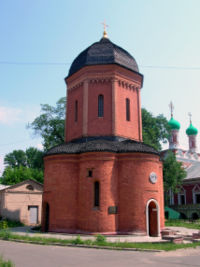 |
B
| Portrait | Person | Notable works | ||
|---|---|---|---|---|
| Gavriil Baranovsky Gavriil Baranovsky Gavriil Vasilyevich Baranovsky was a Ukrainian-born Russian architect, civil engineer, art historian and publisher, who worked primarily in Saint Petersburg for the Elisseeff family, but also practiced in Moscow and produced the first town plan for Murmansk .-Education and early career:Born in... (1860–1920)  Russian Empire Russian Empireeclectics and Art Nouveau architect |
Baltic Shipyard Baltic Shipyard The Baltic Shipyard is one of the oldest shipyards in Russia. It is located in Saint Petersburg in the south-western part of the Vasilievsky Island. It is one of the three shipyards active in Saint Petersburg... workshops (assistant to Ernest Gibert), St. Petersburg, 1880; Elisseeff Emporium, St. Petersburg, 1900–03; Buddhist Temple, St. Petersburg, 1909-15. |
 |
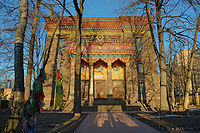 |
|
| Petr Baranovsky Petr Baranovsky Pyotr Dmitrievich Baranovsky was a Russian architect, preservationist and restorator who reconstructed many ancient buildings on the territory of Soviet Union... (1892–1984)  Russian Empire Russian Empire Soviet Union Soviet Unionarchitect, preservationist, restorer |
Credited with saving Saint Basil's Cathedral Saint Basil's Cathedral The Cathedral of the Protection of Most Holy Theotokos on the Moat , popularly known as Saint Basil's Cathedral , is a Russian Orthodox church erected on the Red Square in Moscow in 1555–61. Built on the order of Ivan the Terrible to commemorate the capture of Kazan and Astrakhan, it marks the... from destruction in the early 1930s, founding and managing the Kolomenskoye Kolomenskoye Kolomenskoye is a former royal estate situated several kilometers to the south-east of the city-centre of Moscow, Russia, on the ancient road leading to the town of Kolomna... and Andrei Rublev Andrei Rublev Andrei Rublev is considered to be the greatest medieval Russian painter of Orthodox icons and frescoes.-Biography:... museums, and developing modern restoration technologies; restored Golden Gate Golden Gate (Vladimir) The Golden Gates of Vladimir , constructed between 1158 and 1164, are the only preserved instance of the ancient Russian city gates. A museum inside focuses on the history of the Mongol invasion of Russia in the 13th century.... in Vladimir Vladimir Vladimir is a city and the administrative center of Vladimir Oblast, Russia, located on the Klyazma River, to the east of Moscow along the M7 motorway. Population:... ; restored Krutitsy Metochion Krutitsy Krutitsy Metochion , full name: Krutitsy Patriarchal Metochion is an operating ecclesiastical estate of Russian Orthodox Church, located in Tagansky District of Moscow, Russia, 3 kilometers south-east from the Kremlin. The name Krutitsy , i.e. steep river banks, originally meant the hills... in Moscow Moscow Moscow is the capital, the most populous city, and the most populous federal subject of Russia. The city is a major political, economic, cultural, scientific, religious, financial, educational, and transportation centre of Russia and the continent... . |
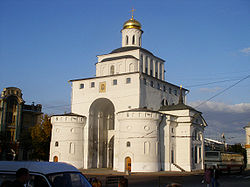 |
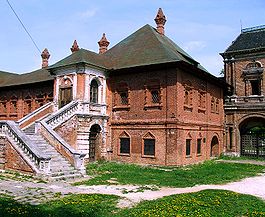 |
|
| Vasili Bazhenov Vasili Bazhenov Vasily Ivanovich Bazhenov was a Russian neoclassical architect, graphic artist, architectural theorist and educator... (1737–1799)  Russian Empire Russian Empireneoclassical and Gothic Revival architect, graphic artist, architectural theorist and educator |
Moscow Moscow Moscow is the capital, the most populous city, and the most populous federal subject of Russia. The city is a major political, economic, cultural, scientific, religious, financial, educational, and transportation centre of Russia and the continent... 's Tsaritsyno Park buildings (first palace, Figurny Bridge, Opera House), 1775–86; Pashkov House Pashkov House The Pashkov House is the famous Neoclassical mansion that stands on a hill opposite the western wall of the Moscow Kremlin, near the crossing of the Mokhovaya and Vozdvizhenka streets. Its design has been attributed to Vasily Bazhenov. It used to be home to the Rumyantsev Museum in the 19th century... in Moscow Moscow Moscow is the capital, the most populous city, and the most populous federal subject of Russia. The city is a major political, economic, cultural, scientific, religious, financial, educational, and transportation centre of Russia and the continent... (attribution disputed), 1784—86. |
 |
||
| Leon Benois Leon Benois Leon Benois was a Russian architect. He was the son of architect Nicholas Benois, the brother of artists Alexandre Benois and Albert Benois, and the grandfather of the actor Sir Peter Ustinov... (1856–1928)  Russian Empire Russian Empire Soviet Union Soviet Union(French French people The French are a nation that share a common French culture and speak the French language as a mother tongue. Historically, the French population are descended from peoples of Celtic, Latin and Germanic origin, and are today a mixture of several ethnic groups... descent) eclectical, neoclassical, Neo-Gothic and Russian Revival architect (son of Nicholas Benois Nicholas Benois Nicholas Benois was a Russian architect who worked in Peterhof and other suburbs of St Petersburg.Benois was born of French parents in Russia and studied at the Imperial Academy of Arts from 1827 to 1836... ) |
Roman Catholic cathedral of Notre-Dame Blessed Virgin Mary (Roman Catholic) Roman Catholic veneration of the Blessed Virgin Mary is based on Holy Scripture: In the fullness of time, God sent his son, born of a virgin. The mystery of the incarnation of the Son of God through Mary thus signifies her honour as Mother of God... of Lourdes Lourdes Lourdes is a commune in the Hautes-Pyrénées department in the Midi-Pyrénées region in south-western France.Lourdes is a small market town lying in the foothills of the Pyrenees, famous for the Marian apparitions of Our Lady of Lourdes occurred in 1858 to Bernadette Soubirous... in St. Petersburg (together with Marian Peretyatkovich Marian Peretyatkovich Marian Marianovich Peretyatkovich was a Ukrainian-born Russian architect. His premature death at the age of 43 limited his career to only eight years of independent practice , however, he managed to excel in a rational variety of late Art Nouveau, Renaissance Revival and Russian Revival in Saint... ), 1903–09; Alexander Nevsky Cathedral, Warsaw Alexander Nevsky Cathedral, Warsaw The Alexander Nevsky Cathedral was a Russian Orthodox Cathedral in Saxon Square built by authorities of Imperial Russia in Warsaw, Poland, then under the rule of the Russian Empire. The cathedral was designed by distinguished Russian architect Leon Benois, and was built between 1894 and 1912... (later demolished), 1894—1912; The House of Benua in St. Petersburg (together with Albert Benois Albert Benois Albert Nikolayevitch Benois was a talented Russian water-colorist. The Benois family produced many talented artists over several generations. Albert was the elder son of architect Nicholas Benois, brother of artist and theatrical designer Alexander Benois, uncle of the painter Zinaida... and Yuly Benois), 1911-14. |
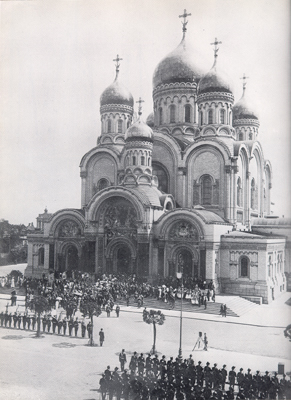 |
||
| Nicholas Benois Nicholas Benois Nicholas Benois was a Russian architect who worked in Peterhof and other suburbs of St Petersburg.Benois was born of French parents in Russia and studied at the Imperial Academy of Arts from 1827 to 1836... (1813–1898)  Russian Empire Russian Empire(French French people The French are a nation that share a common French culture and speak the French language as a mother tongue. Historically, the French population are descended from peoples of Celtic, Latin and Germanic origin, and are today a mixture of several ethnic groups... descent) Gothic Revival architect (father of Leon Benois Leon Benois Leon Benois was a Russian architect. He was the son of architect Nicholas Benois, the brother of artists Alexandre Benois and Albert Benois, and the grandfather of the actor Sir Peter Ustinov... , Alexander Benois and Albert Benois Albert Benois Albert Nikolayevitch Benois was a talented Russian water-colorist. The Benois family produced many talented artists over several generations. Albert was the elder son of architect Nicholas Benois, brother of artist and theatrical designer Alexander Benois, uncle of the painter Zinaida... ) |
A court architect to Nicholas I of Russia Nicholas I of Russia Nicholas I , was the Emperor of Russia from 1825 until 1855, known as one of the most reactionary of the Russian monarchs. On the eve of his death, the Russian Empire reached its historical zenith spanning over 20 million square kilometers... , he oversaw many projects in the imperial residence in Petergof, notably the Principal Imperial Stables, 1847–52; rebuilt the fountain cascades of Petergof; designed the number of the first railway stations in Russia, like in Strelna Strelna Strelna is a municipal settlement in Petrodvortsovy District of the federal city of St. Petersburg, Russia, situated about halfway between St. Petersburg proper and Petergof and overlooking the shore of the Gulf of Finland... , Tsarskoe Selo, and New Petergof (latter in 1857). |
|||
| Alexander Bernadazzi (1831-1907) |
||||
| Karl Blank Karl Blank Karl Blank was a Russian architect, notable as one of the last practitioners of Baroque architecture and the first Moscow architect to build early neoclassical buildings. His surviving, undisputed legacy consists of three baroque churches and Moscow Orphanage... (1728-1793) |
 |
|||
| Ilya Bondarenko Ilya Bondarenko Ilya Yevgrafovich Bondarenko was a Russian-Soviet architect, historian and preservationist, notable for developing a particular style of Old Believers architecture in 1905-1917, blending Northern Russian revival with Art Nouveau.-Education and early works:... (1867-1947) |
 |
|||
| Joseph Bové Joseph Bové Joseph Bové was a Russian neoclassical architect with Italian roots who supervised reconstruction of Moscow after the Fire of 1812.-Biography:... (1784-1834) |
||||
.jpg) |
Vincenzo Brenna Vincenzo Brenna Vincenzo Brenna was an Italian architect and painter who was the house architect of Paul I of Russia. Brenna was hired by Paul and his spouse Maria Fyodorovna as interior decorator in 1781 and by the end of 1780s became the couple's leading architect... (1745-1820) |
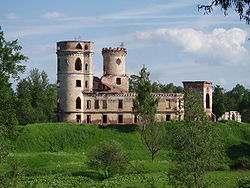 |
||
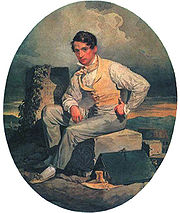 |
Alexander Brullov Alexander Brullov Alexander Pavlovich Brullov was a Russian artist associated with the latest phase of the Russian Neoclassicism.Alexander Brullov was born in Saint Petersburg into a family of French artists: his great grandfather, his grandfather, his father and his brothers were artists. His first teacher was... (1798–1877)  Russian Empire Russian Empire(French French people The French are a nation that share a common French culture and speak the French language as a mother tongue. Historically, the French population are descended from peoples of Celtic, Latin and Germanic origin, and are today a mixture of several ethnic groups... descent) Neoclassical architect and painter (self-portrait) |
Most of his works were created in St. Petersburg: Mikhaylovsky Theatre Mikhaylovsky Theatre The Mikhaylovsky Theatre is one of the oldest opera and ballet houses in Russia. It was founded in 1833 and is situated in a historical building on the Arts Square in St. Petersburg... , 1831–33; Lutheran Church of St. Peter and St. Paul, 1833–38; Pulkovo Observatory Pulkovo Observatory The Pulkovo Astronomical Observatory астрономи́ческая обсервато́рия Росси́йской акаде́мии нау́к), the principal astronomical observatory of the Russian Academy of Sciences, located 19 km south of Saint Petersburg on Pulkovo Heights... , 1834–39; the Headquarters of Guard Corps on Palace Square Palace Square Palace Square , connecting Nevsky Prospekt with Palace Bridge leading to Vasilievsky Island, is the central city square of St Petersburg and of the former Russian Empire... , 1837–43; Pompei Hall, the Malachite Room Malachite Room of the Winter Palace The Malachite Room of the Winter Palace, St Petersburg, was designed in the late 1830s by the architect Alexander Briullov for use a formal reception room for the Empress Alexandra Fyodorovna, wife of Nicholas I. It replaced the Jasper Room, which was destroyed in the fire of 1837. The room obtains... and the White Hall in Winter Palace Winter Palace The Winter Palace in Saint Petersburg, Russia, was, from 1732 to 1917, the official residence of the Russian monarchs. Situated between the Palace Embankment and the Palace Square, adjacent to the site of Peter the Great's original Winter Palace, the present and fourth Winter Palace was built and... (after 1837). |
 |
C
| Portrait | Person | Notable works | ||
|---|---|---|---|---|
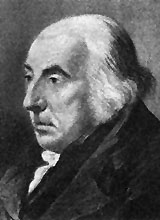 |
Charles Cameron Charles Cameron (architect) Charles Cameron was a Scottish architect who made an illustrious career at the court of Catherine II of Russia. Cameron, practitioner of early neoclassical architecture, was the chief architect of Tsarskoye Selo and Pavlovsk palaces and the adjacent new town of Sophia from his arrival in Russia in... (1743–1812) |
|||
| Francesco Camporesi Francesco Camporesi Francesco Camporesi was an Italian architect, painter, engraver and educator who worked in Moscow in 1780s-1820s. Most of his architectural work perished in the Fire of 1812, was severely altered, demolished or otherwise lost.... (1747–1831) |
.jpg) |
|||
| Alberto Cavos Alberto Cavos Alberto Cavos was a Russian–Italian architect best known for his theatre designs, the builder of the Mariinsky Theatre in Saint Petersburg and the Bolshoi Theatre in Moscow .-Early years:Alberto Cavos was born in Saint Petersburg to Venetian opera composer Catterino Cavos Alberto Cavos (Russified... (1800–1863)  Russian Empire Russian Empire(Italian Italian people The Italian people are an ethnic group that share a common Italian culture, ancestry and speak the Italian language as a mother tongue. Within Italy, Italians are defined by citizenship, regardless of ancestry or country of residence , and are distinguished from people... descent) neoclassical architect, theatre designer (the grandfather of Albert Benois Albert Benois Albert Nikolayevitch Benois was a talented Russian water-colorist. The Benois family produced many talented artists over several generations. Albert was the elder son of architect Nicholas Benois, brother of artist and theatrical designer Alexander Benois, uncle of the painter Zinaida... , Leon Benois Leon Benois Leon Benois was a Russian architect. He was the son of architect Nicholas Benois, the brother of artists Alexandre Benois and Albert Benois, and the grandfather of the actor Sir Peter Ustinov... and Alexander Benois) |
Rebuilt the Bolshoi Kamenny Theatre Bolshoi Kamenny Theatre The Saint Petersburg Imperial Bolshoi Kamenny Theatre was a theatre in Saint Petersburg.- History :It was built in 1783 to Antonio Rinaldi's Neoclassical design as the Kamenny Theatre. It was rebuilt in 1802 and renamed the Bolshoi, but burned down in 1811. The building was restored in 1818, and... in St. Petersburg, 1826-36 (mostly demolished and replaced by Saint Petersburg Conservatory Saint Petersburg Conservatory The N. A. Rimsky-Korsakov Saint Petersburg State Conservatory is a music school in Saint Petersburg. In 2004, the conservatory had around 275 faculty members and 1,400 students.-History:... ); the Bolshoi Theatre Bolshoi Theatre The Bolshoi Theatre is a historic theatre in Moscow, Russia, designed by architect Joseph Bové, which holds performances of ballet and opera. The Bolshoi Ballet and Bolshoi Opera are amongst the oldest and most renowned ballet and opera companies in the world... in Moscow Moscow Moscow is the capital, the most populous city, and the most populous federal subject of Russia. The city is a major political, economic, cultural, scientific, religious, financial, educational, and transportation centre of Russia and the continent... , 1853–56; completed rebuilding of the Mikhaylovsky Theatre Mikhaylovsky Theatre The Mikhaylovsky Theatre is one of the oldest opera and ballet houses in Russia. It was founded in 1833 and is situated in a historical building on the Arts Square in St. Petersburg... in St. Petersburg, 1859; the Mariinsky Theatre Mariinsky Theatre The Mariinsky Theatre is a historic theatre of opera and ballet in Saint Petersburg, Russia. Opened in 1860, it became the preeminent music theatre of late 19th century Russia, where many of the stage masterpieces of Tchaikovsky, Mussorgsky, and Rimsky-Korsakov received their premieres. The... in St. Petersburg, 1859–60. |
|||
| Serge Chermayeff Serge Chermayeff Serge Ivan Chermayeff was a Russian born, British architect, industrial designer, writer, and co-founder of several architectural societies, including the American Society of Planners and Architects.... (1900–1996) |
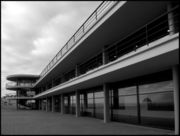 |
D
| Portrait | Person | Notable works | ||
|---|---|---|---|---|
| Alexey Dushkin Alexey Dushkin Alexey Nikolayevich Dushkin was a Soviet architect, best known for his 1930s designs of Kropotkinskaya and Mayakovskaya stations of Moscow Metro... (1904-1977) |
E
| Portrait | Person | Notable works | ||
|---|---|---|---|---|
| Mikhail Eisenstein Mikhail Eisenstein Mikhail Osipovich Eisenstein, , was a Russian architect and civil engineer. His paternal grandparents being German Jews, had converted to Orthodox Christianity, and his maternal grandparents were Swedes. He graduated from the Institute of Civic Engineering in St. Petersburg in 1893. He was the... (1867-1921) |
 |
 |
F
| Portrait | Person | Notable works | ||
|---|---|---|---|---|
| Yury Felten Yury Felten Yury Matveyevich Felten was a court architect to Catherine the Great, Empress of Russia.Yuri Felten was born Georg Veldten, into a family of German immigrants in Russia. His father worked for the Russian Academy of Sciences... (1730–1801)  Russian Empire Russian Empire(German descent) baroque, neoclassical and Gothic Revival architect, engineer |
A court architect to Catherine the Great, he created most of his works in St. Petersburg: a heavy-lifting machine that moved the enormous Thunder Stone rock, the pedestal of the Bronze Horseman, 1770; Chesme Church Chesme Church The Chesme Church , also called the Church of the Nativity of St. John the Baptist, is a small Russian Orthodox church at 12 Lensoveta Street, in Saint Petersburg, Russia. It was built by the Russian court architect Yury Felten in 1780 at the direction of Catherine the Great, Empress of Russia... and Palace, 1770–80; iron-cast grille of the Summer Garden Summer Garden The Summer Garden occupies an island between the Fontanka, Moika, and the Swan Canal in Saint Petersburg and shares its name with the adjacent Summer Palace of Peter the Great.-Original:... , 1783; granite Granite Granite is a common and widely occurring type of intrusive, felsic, igneous rock. Granite usually has a medium- to coarse-grained texture. Occasionally some individual crystals are larger than the groundmass, in which case the texture is known as porphyritic. A granitic rock with a porphyritic... embankments of Neva, 1764–84 the Old Hermitage Hermitage Museum The State Hermitage is a museum of art and culture in Saint Petersburg, Russia. One of the largest and oldest museums of the world, it was founded in 1764 by Catherine the Great and has been opened to the public since 1852. Its collections, of which only a small part is on permanent display,... wing of the Winter Palace Winter Palace The Winter Palace in Saint Petersburg, Russia, was, from 1732 to 1917, the official residence of the Russian monarchs. Situated between the Palace Embankment and the Palace Square, adjacent to the site of Peter the Great's original Winter Palace, the present and fourth Winter Palace was built and... , 1771-87. |
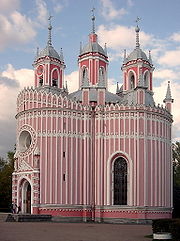 |
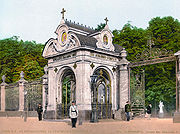 |
|
| Aristotile Fioravanti Aristotile Fioravanti Ridolfo "Aristotele" Fioravanti was an Italian Renaissance architect and engineer. His surname is sometimes given as Fieraventi. Russian versions of his name are Фиораванти, Фьораванти, Фиеравенти, Фиораванте.... (1415-1420 – c. 1486)  Italy ItalyGrand Duchy of Moscow Grand Duchy of Moscow The Grand Duchy of Moscow or Grand Principality of Moscow, also known in English simply as Muscovy , was a late medieval Rus' principality centered on Moscow, and the predecessor state of the early modern Tsardom of Russia.... Renaissance architect and engineer |
Palazzo del Podestà Palazzo del Podestà The Palazzo del Podestà is a civic building in Bologna, northern Italy.The edifice was built around 1200 as the seat of the local podestà, the various functionaries of the commune. It stands on the Piazza Maggiore, near the Palazzo Communale and facing the Basilica of St. Petronio... , Bologna Bologna Bologna is the capital city of Emilia-Romagna, in the Po Valley of Northern Italy. The city lies between the Po River and the Apennine Mountains, more specifically, between the Reno River and the Savena River. Bologna is a lively and cosmopolitan Italian college city, with spectacular history,... , Italy Italy Italy , officially the Italian Republic languages]] under the European Charter for Regional or Minority Languages. In each of these, Italy's official name is as follows:;;;;;;;;), is a unitary parliamentary republic in South-Central Europe. To the north it borders France, Switzerland, Austria and... , 1453; Dormition Cathedral, Moscow, 1475–79. |
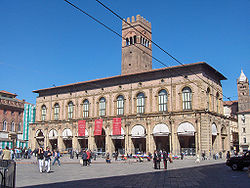 |
.jpg) |
|
| Ivan Fomin Ivan Fomin Ivan Aleksandrovich Fomin was a Russian architect and educator. He began his career in 1899 in Moscow, working in the Art Nouveau style. After relocating to Saint Petersburg in 1905, he became an established master of the Neoclassical Revival movement... (1872-1936) |
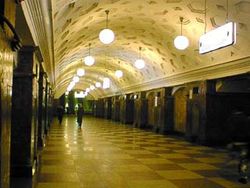 |
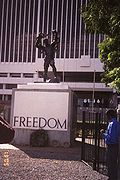 |
G
| Portrait | Person | Notable works | ||
|---|---|---|---|---|
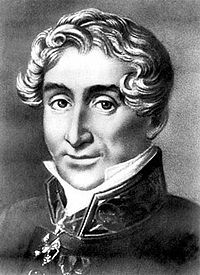 |
Domenico Gilardi (1785-1845) |
 |
 |
|
| Moisei Ginzburg Moisei Ginzburg Moisei Yakovlevich Ginzburg was a Soviet constructivist architect, best known for his 1929 Narkomfin Building in Moscow.-Education:Ginzburg was born in Minsk in a Jewish real estate developer's family. He graduated from Milano Academy and Riga polytechnic institute . During Russian Civil War he... (1892-1946) |
 |
 |
||
| Ilya Golosov Ilya Golosov Ilya Alexandrovich Golosov was a Russian Soviet architect. A leader of Constructivism in 1925-1931, Ilya Golosov later developed his own style of early stalinist architecture known as postconstructivism... (1883-1945) |
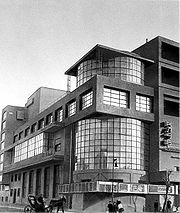 |
 |
||
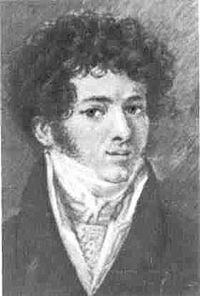 |
Afanasy Grigoriev Afanasy Grigoriev Afanasy Grigorievich Grigoriev was a Russian Neoclassical architect, who worked in Moscow and its suburbs. Grigoriev is remembered for his refined Empire style mansions, completion of Great Ascension Church and assistance to Domenico Giliardi in rebuilding Moscow after the Great Fire... (1782-1868) |
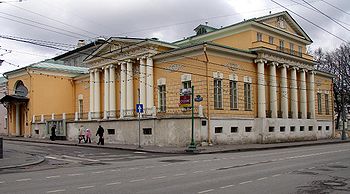 |
 |
|
| Alexey Gornostaev Alexey Gornostaev Alexey Maksimovich Gornostaev was a Russian architect, notable as a pioneer in Russian Revival, the builder of Valaam Monastery hermitages, Trinity-Sergius Convent in Saint Petersburg and Uspenski Cathedral in Helsinki... (1808–1862) |
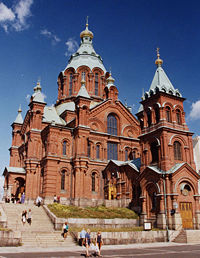 |
|||
| Fyodor Gornostaev Fyodor Gornostaev Fyodor Fyodorovich Gornostaev was a Russian architect and preservationist, notable for his folk interpretation of Russian Revival and restoration of landmark buildings in Suzdal, Kursk and Moscow Kremlin.... (1867–1915) |
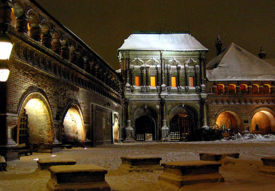 |
|||
| David Grimm (1823–1898)  Russian Empire Russian Empireneo-Byzantine and Russian Revival style architect |
Grimm designed numerous Orthodox churches in Western Europe Western Europe Western Europe is a loose term for the collection of countries in the western most region of the European continents, though this definition is context-dependent and carries cultural and political connotations. One definition describes Western Europe as a geographic entity—the region lying in the... , Jerusalem and Russian Empire Russian Empire The Russian Empire was a state that existed from 1721 until the Russian Revolution of 1917. It was the successor to the Tsardom of Russia and the predecessor of the Soviet Union... : Church of Maria Magdalene Church of Maria Magdalene The Church of Mary Magdalene is a Russian Orthodox church located on the Mount of Olives, near the Garden of Gethsemane in Jerusalem, Israel.-History:... in Jerusalem, 1885–88; Cathedral of Saint Alexander Nevsky Alexander Nevsky Cathedral, Tiflis The St. Alexander Nevsky Military Cathedral of Tiflis was an Orthodox Christian cathedral in downtown Tiflis , Georgia, constructed during the Imperial Russian rule in the 1871-1872 and 1889-1897 and demolished by the Soviet authorities in 1930... , Tbilisi Tbilisi Tbilisi is the capital and the largest city of Georgia, lying on the banks of the Mt'k'vari River. The name is derived from an early Georgian form T'pilisi and it was officially known as Tiflis until 1936... , 1871-97 (demolished); Saint Vladimir Cathedral in Chersonesos, Crimea Crimea Crimea , or the Autonomous Republic of Crimea , is a sub-national unit, an autonomous republic, of Ukraine. It is located on the northern coast of the Black Sea, occupying a peninsula of the same name... , 1858-97. |
H
| Portrait | Person | Notable works | ||
|---|---|---|---|---|
 |
Viktor Hartmann Viktor Hartmann Viktor Alexandrovich Hartmann was a Russian architect and painter. He was associated with the Abramtsevo Colony, purchased and preserved beginning in 1870 by Savva Mamontov, and the Russian Revival.-Life:Victor-Edouard Hartmann was born in St... (1834–1873) |
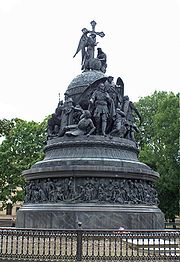 |
||
| William Heste William Heste William Hastie was a Russian architect, civil engineer and town planner of Scottish descent. His name is also transliterated back from Russian as William Heste or, seldom, Vasily Heste.... (Hastie) (1763-1832) |
I
| Portrait | Person | Notable works | ||
|---|---|---|---|---|
| Boris Iofan Boris Iofan Boris Mihailovich Iofan was a Russian Soviet architect, known for his Stalinist architecture buildings like 1931 House on Embankment and the 1931-1933 winning draft of the Palace of Soviets.- Background :... (1891–1976)  Russian Empire Russian Empire Soviet Union Soviet Unionconstructivist and Stalin Empire style architect |
House on Embankment House on Embankment The House on the Embankment is a block-wide apartment house in downtown Moscow, Russia. It was completed in 1931 as the Government Building, a residence of Soviet elite... , Moscow Moscow Moscow is the capital, the most populous city, and the most populous federal subject of Russia. The city is a major political, economic, cultural, scientific, religious, financial, educational, and transportation centre of Russia and the continent... , 1928–31; 1931-33 winning draft of the Palace of Soviets Palace of Soviets The Palace of the Soviets was a project to construct an administrative center and a congress hall in Moscow, Russia, near the Kremlin, on the site of the demolished Cathedral of Christ the Saviour... (never built); Soviet Pavilions at 1937 World's Fair in Paris Paris Paris is the capital and largest city in France, situated on the river Seine, in northern France, at the heart of the Île-de-France region... and 1939 World's Fair 1939 New York World's Fair The 1939–40 New York World's Fair, which covered the of Flushing Meadows-Corona Park , was the second largest American world's fair of all time, exceeded only by St. Louis's Louisiana Purchase Exposition of 1904. Many countries around the world participated in it, and over 44 million people... in New York New York New York is a state in the Northeastern region of the United States. It is the nation's third most populous state. New York is bordered by New Jersey and Pennsylvania to the south, and by Connecticut, Massachusetts and Vermont to the east... ; Baumanskaya station of Moscow Metro Moscow Metro The Moscow Metro is a rapid transit system serving Moscow and the neighbouring town of Krasnogorsk. Opened in 1935 with one line and 13 stations, it was the first underground railway system in the Soviet Union. As of 2011, the Moscow Metro has 182 stations and its route length is . The system is... , 1944. |
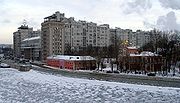 |
||
| Illarion Ivanov-Schitz Illarion Ivanov-Schitz Illarion Ivanovich Ivanov-Schitz was a Russian architect, notable for developing a unique personal style, blending the Vienna Secession school of Otto Wagner with Greek Revival features. His career peaked in 1902-1912 with several Moscow buildings including the Morozov Hospital, the Merchant Club... (1865-1937) |
K
| Portrait | Person | Notable works | ||
|---|---|---|---|---|
| Alexander Kaminsky Alexander Kaminsky Alexander Stepanovich Kaminsky was a Russian architect working in Moscow and suburbs. One of the most successul and prolific architects of 1860s - 1880s, Kaminsky was a faithful eclecticist, equally skilled in Russian Revival, Neo-Gothic and Renaissance Revival architecture... (1829-1897 |
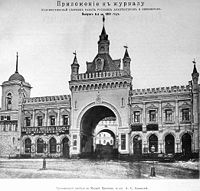 |
|||
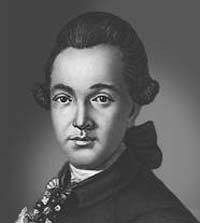 |
Matvey Kazakov Matvey Kazakov Matvey Fyodorovich Kazakov was a Russian Neoclassical architect. Kazakov was one of the most influential Muscovite architects during the reign of Catherine II, completing numerous private residences, two royal palaces, two hospitals, Moscow University, and the Kremlin Senate... (1738-1812) |
 |
||
| Lev Kekushev Lev Kekushev Lev Nikolayevich Kekushev was a Russian architect, notable for his Art Nouveau buildings in Moscow, built in the 1890s and early 1900s in the original, Franco-Belgian variety of this style... (1862–1919) |
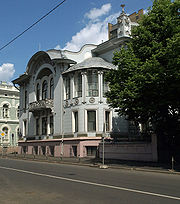 |
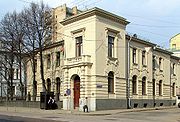 |
||
| Roman Klein Roman Klein Roman Ivanovich Klein , born Robert Julius Klein, was a Russian architect and educator, best known for his Neoclassical Pushkin Museum in Moscow. Klein, an eclectic, was one of the most prolific architects of his period, second only to Fyodor Schechtel... (1858-1924) |
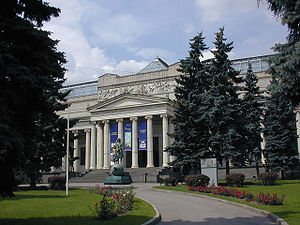 |
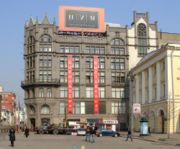 |
||
 |
Alexander Kokorinov Alexander Kokorinov Alexander Filippovich Kokorinov was a Russian architect and educator, one of the founders, the first builder, director and rector of the Imperial Academy of Arts in Saint Peterburg. Kokorinov has been house architect of the Razumovsky family and Ivan Shuvalov, the first President of the Academy... (1726-1772) |
 |
||
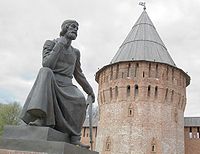 |
Fyodor Kon Fyodor Kon Fyodor Savelyevich Kon was a 16th century Russian military engineer and architect, the builder of Smolensk Kremlin and the Bely Gorod fortification ring of Moscow .... (fl. Floruit Floruit , abbreviated fl. , is a Latin verb meaning "flourished", denoting the period of time during which something was active... 1585–1600) Tsardom of Russia Tsardom of Russia The Tsardom of Russia was the name of the centralized Russian state from Ivan IV's assumption of the title of Tsar in 1547 till Peter the Great's foundation of the Russian Empire in 1721.From 1550 to 1700, Russia grew 35,000 km2 a year... fortification engineer and architect a monument in Smolensk Smolensk Smolensk is a city and the administrative center of Smolensk Oblast, Russia, located on the Dnieper River. Situated west-southwest of Moscow, this walled city was destroyed several times throughout its long history since it was on the invasion routes of both Napoleon and Hitler. Today, Smolensk... Kremlin Kremlin A kremlin , same root as in kremen is a major fortified central complex found in historic Russian cities. This word is often used to refer to the best-known one, the Moscow Kremlin, or metonymically to the government that is based there... on photo |
the walls and towers of Novospassky Monastery Novospassky Monastery Novospassky Monastery is one of the fortified monasteries surrounding Moscow from south-east.It was the first monastery to be founded in Moscow in the early 14th century. The Saviour Church was its original katholikon... in Moscow Moscow Moscow is the capital, the most populous city, and the most populous federal subject of Russia. The city is a major political, economic, cultural, scientific, religious, financial, educational, and transportation centre of Russia and the continent... and several other Russian monasteries; Bely Gorod Bely Gorod Bely Gorod is the central core area of Moscow, Russia. The name comes from the color of its defensive wall, which was erected in 1585-1593 at the behest of tsar Feodor I and Boris Godunov by architect Fyodor Kon... fortification ring of Moscow Moscow Moscow is the capital, the most populous city, and the most populous federal subject of Russia. The city is a major political, economic, cultural, scientific, religious, financial, educational, and transportation centre of Russia and the continent... , 1585–93 (in 18th-19th centuries replaced with the Boulevard Ring Boulevard Ring The Boulevard Ring is Moscow's second centremost ring road . Boulevards form a semicircular chain along the western, northern and eastern sides of the historical White City of Moscow; in the south the incomplete ring is terminated by the embankments of Moskva River... ); Smolensk Smolensk Smolensk is a city and the administrative center of Smolensk Oblast, Russia, located on the Dnieper River. Situated west-southwest of Moscow, this walled city was destroyed several times throughout its long history since it was on the invasion routes of both Napoleon and Hitler. Today, Smolensk... Kremlin Kremlin A kremlin , same root as in kremen is a major fortified central complex found in historic Russian cities. This word is often used to refer to the best-known one, the Moscow Kremlin, or metonymically to the government that is based there... , the largest one in Russia Russia Russia or , officially known as both Russia and the Russian Federation , is a country in northern Eurasia. It is a federal semi-presidential republic, comprising 83 federal subjects... , 1597–1602. |
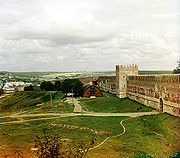 |
|
 |
Ivan Kuznetsov Ivan Sergeyevich Kuznetsov Ivan Sergeyevich Kuznetsov was a Russian architect primarily known for his pre-1917 works in Moscow, Moscow suburbs, and Vichuga. Born into a working-class family, Kuznetsov independently broke into the elite architecture society of Moscow. He worked in many different styles, but was most... (1867-1942) |
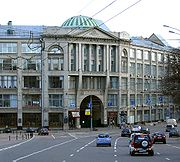 |
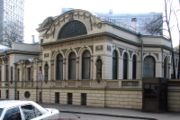 |
|
| Andrey Kvasov Andrey Kvasov Andrey Vasilievich Kvasov was a notable Baroque architect who worked in Russia and Ukraine. Very little is known about his life, and its dates are still uncertain. Only a handful of his buildings, though much altered, still stand.... (1720–1770) |
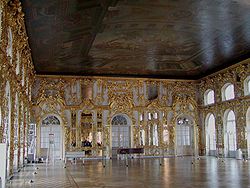 |
L
| Portrait | Person | Notable works | ||
|---|---|---|---|---|
| Nikolai Ladovsky Nikolai Ladovsky Nikolai Alexandrovich Ladovsky was a Russian avant-garde architect and educator, leader of the rationalist movement in 1920s architecture, an approach emphasizing human perception of space and shape... (1881-1941) |
||||
| Nikolay Lanceray Nikolay Lanceray Nikolay Lanceray was a Russian architect, preservationist, illustrator of books and historian of neoclassical art, biographer of Charles Cameron, Vincenzo Brenna and Andreyan Zakharov... (1880–1942) |
||||
| Nikita Lazarev Nikita Lazarev Nikita Gerasimovich Lazarev was a Russian civil engineer, contractor, real estate developer and Neoclassical architect, notable for his 1906 Mindovsky House in Khamovniki District of Moscow... (1866-1932) |
||||
| Ivan Leonidov Ivan Leonidov Ivan Ilich Léonidov was a Russian constructivist architect, urban planner, painter and teacher.-Early life:... (1902-1959) |
||||
| El Lissitzky El Lissitzky , better known as El Lissitzky , was a Russian artist, designer, photographer, typographer, polemicist and architect. He was an important figure of the Russian avant garde, helping develop suprematism with his mentor, Kazimir Malevich, and designing numerous exhibition displays and propaganda works... (1890–1941) |
||||
| Berthold Lubetkin Berthold Lubetkin Berthold Romanovich Lubetkin was a Russian émigré architect who pioneered modernist design in Britain in the 1930s. His work includes the Highpoint housing complex, London Zoo penguin pool, Finsbury Health Centre and Spa Green Estate.-Early years:Berthold Lubetkin was born in Tiflis into a Jewish... (1901-1990) |
M
| Portrait | Person | Notable works | ||
|---|---|---|---|---|
| Ivan Mashkov Ivan Mashkov Ivan Pavlovich Mashkov was a Russian architect and preservationist, notable for surveying and restoration of Dormition Cathedral of Moscow Kremlin, Novodevichy Convent and other medieval buildings. His best known extant building is Sokol luxury Art Nouveau apartment building in Kuznetsky Most... (1867–1945) |
||||
| Georg Johann Mattarnovy Georg Johann Mattarnovy Georg Johann Mattarnovi was a German Baroque architect and sculptor, notable for his work in Saint Petersburg.The birthplace of Mattarnovi is unknown, but most probably it was Prussia. His year of birth is also unknown. He was a sculptor, and a disciple and assistant of German architect Andreas... (?-1719)  Holy Roman Empire Holy Roman EmpireTsardom of Russia Tsardom of Russia The Tsardom of Russia was the name of the centralized Russian state from Ivan IV's assumption of the title of Tsar in 1547 till Peter the Great's foundation of the Russian Empire in 1721.From 1550 to 1700, Russia grew 35,000 km2 a year... Baroque architect and sculptor |
The Third Winter Palace, St. Petersburg, 1719–21; Kunstkamera Kunstkamera The Kunstkamera was the first museum in Russia. Established by Peter the Great and completed in 1727, the Kunstkammer Building hosts the Peter the Great Museum of Anthropology and Ethnography, with a collection of almost 2,000,000 items... , St. Petersburg, 1719-27. |
 |
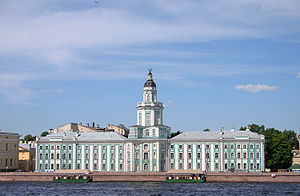 |
|
| Konstantin Melnikov Konstantin Melnikov Konstantin Stepanovich Melnikov was a Russian architect and painter. His architectural work, compressed into a single decade , placed Melnikov on the front end of 1920s avant-garde architecture... (1890-1974) |
||||
| Adam Menelaws Adam Menelaws Adam Menelaws, also spelled Menelas was an architect and landscape designer of Scottish origin, active in the Russian Empire from 1784 to 1831... |
||||
| Miron Merzhanov Miron Merzhanov Miron Ivanovich Merzhanov, born Meran Merzhanyantz , was a Soviet architect of Armenian descent, notable for being the de-facto personal architect of Joseph Stalin in 1933–1941... (1895-1975) |
||||
| Maximilian Messmacher Maximilian Messmacher Maximilian Egorovich Messmacher was a Russian architect of German ancestry. He attended the School of Painting of St. Petersburg Society for the Encouragement of Arts and thereafter the Imperial Academy of Arts, graduating in 1866... (1842-1906) |
||||
| Ivan Michurin Ivan Fyodorovich Michurin Ivan Fyodorovich Michurin was a Russian architect whose designs marked a transition of Russian architecture from early Muscovite Baroque to mature Rastrelliesque style.... (1700–1763) |
||||
| Ippolit Monighetti Ippolit Monighetti Ippolit Antonovich Monighetti was a Russian architect of Swiss descent who worked for the Romanov family.Monighetti attended the Stroganov Art School and then studied at the Imperial Academy of Arts under Alexander Brullov, matriculating in 1839 with a gold medal... (1819–1878) |
||||
| Auguste de Montferrand Auguste de Montferrand Auguste de Montferrand was a French Neoclassical architect who worked primarily in Russia. His two best known works are the Saint Isaac's Cathedral and the Alexander Column in St. Petersburg.-Family:... (1786-1858) |
||||
| Arkady Mordvinov Arkady Mordvinov Arkady Grigoryevich Mordvinov was a Soviet architect and construction manager, notable for Stalinist architecture of Tverskaya Street, Leninsky Avenue, Hotel Ukraina skyscraper in Moscow and his administrative role in Soviet construction industry and architecture.-VOPRA years:Mordvinov was born in... (1896-1964) |
N
| Portrait | Person | Notable works | ||
|---|---|---|---|---|
| Nikolai Nikitin Nikolai Nikitin Nikolay Nikitkin was a structural designer and construction engineer of the Soviet Union, best known for his monumental structures.-Biography:... (1907–1973)  Russian Empire Russian Empire Soviet Union Soviet Unionstructural designer and construction engineer |
Invented a number of innovative techniques, including the usage of prestressed concrete Prestressed concrete Prestressed concrete is a method for overcoming concrete's natural weakness in tension. It can be used to produce beams, floors or bridges with a longer span than is practical with ordinary reinforced concrete... with wire rope Wire rope thumb|Steel wire rope Wire rope is a type of rope which consists of several strands of metal wire laid into a helix. Initially wrought iron wires were used, but today steel is the main material used for wire ropes.... s; works include: Moscow State University Moscow State University Lomonosov Moscow State University , previously known as Lomonosov University or MSU , is the largest university in Russia. Founded in 1755, it also claims to be one of the oldest university in Russia and to have the tallest educational building in the world. Its current rector is Viktor Sadovnichiy... , 240 m, 1949–53; Warsaw Palace of Culture and Science Warsaw Palace of Culture and Science The Palace of Culture and Science in Warsaw is the tallest building in Poland, the eighth tallest building in the European Union. The building was originally known as the Joseph Stalin Palace of Culture and Science , but in the wake of destalinization the dedication to Stalin was revoked; Stalin's... , 237 m, 1952–55; Luzhniki Stadium Luzhniki Stadium The Grand Sports Arena of the Luzhniki Olympic Complex in Moscow, or briefly Luzhniki Stadium , is the biggest sports stadium in Russia. Its total seating capacity is 78,360 seats, all covered. The stadium is a part of the Luzhniki Olympic Complex, previously called the Central Lenin Stadium... in Moscow Moscow Moscow is the capital, the most populous city, and the most populous federal subject of Russia. The city is a major political, economic, cultural, scientific, religious, financial, educational, and transportation centre of Russia and the continent... , 1955–56; The Motherland Calls The Motherland Calls The Motherland Calls, , also called Mother Motherland, Mother Motherland Is Calling, simply The Motherland, or The Mamayev Monument, is a statue in Mamayev Kurgan in Volgograd, Russia commemorating the Battle of Stalingrad. It was designed by sculptor Yevgeny Vuchetich and structural engineer... statue on Mamayev Kurgan Mamayev Kurgan Mamayev Kurgan is a dominant height overlooking the city of Volgograd in Southern Russia. The name in Russian means "tumulus of Mamai".... in Volgograd Volgograd Volgograd , formerly called Tsaritsyn and Stalingrad is an important industrial city and the administrative center of Volgograd Oblast, Russia. It is long, north to south, situated on the western bank of the Volga River... , 85 m, 1967; Ostankino Tower Ostankino Tower Ostankino Tower is a free-standing television and radio tower in Moscow, Russia. Standing tall, Ostankino was designed by Nikolai Nikitin. It is a member of the World Federation of Great Towers, currently the tallest in Europe and 4th tallest in the world. The tower was the first free-standing... , 540 m, 1963–67; Nikitin-Travush 4000 project (4000 metres, precursor to X-Seed 4000 X-Seed 4000 The X-Seed 4000 is the tallest building ever fully envisioned, meaning that the designs for construction have been completed. The idea was initially created and developed by Peter Neville... ) |
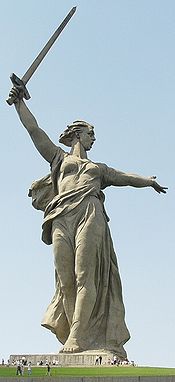 |
||
| Ivan Nikolaev Ivan Nikolaev Ivan Sergeevich Nikolaev was a Soviet architect and educator, notable for his late 1920s constructivist architecture and later work in industrial architecture.... (1901-1979) |
O
| Portrait | Person | Notable works | ||
|---|---|---|---|---|
| Vyacheslav Oltarzhevsky Vyacheslav Oltarzhevsky Vyacheslav Konstantinovich Oltarzhevsky was a Russian Soviet architect. He was one of the first Soviet experts in skyscraper construction, notable for his collaboration with Arkady Mordvinov on Hotel Ukraina... (1880–1966) |
P
| Portrait | Person | Notable works | ||
|---|---|---|---|---|
| Marian Peretyatkovich Marian Peretyatkovich Marian Marianovich Peretyatkovich was a Ukrainian-born Russian architect. His premature death at the age of 43 limited his career to only eight years of independent practice , however, he managed to excel in a rational variety of late Art Nouveau, Renaissance Revival and Russian Revival in Saint... (1872–1916) |
||||
| Petrok Maly Petrok Maly Petrok Maly, also known as Petrok Maly Fryazin , was an Italian architect, who arrived in Moscow together with the envoys of Pope Clement VII in 1528.... (? - c. 1539)  Italy ItalyGrand Duchy of Moscow Grand Duchy of Moscow The Grand Duchy of Moscow or Grand Principality of Moscow, also known in English simply as Muscovy , was a late medieval Rus' principality centered on Moscow, and the predecessor state of the early modern Tsardom of Russia.... |
Credited as a possible architect of the Ascension Church in Kolomenskoye Kolomenskoye Kolomenskoye is a former royal estate situated several kilometers to the south-east of the city-centre of Moscow, Russia, on the ancient road leading to the town of Kolomna... (an early tented roof Tented roof A tented roof is a type of roof widely used in 16th and 17th century Russian architecture for churches. It is like a polygonal spire but differs in purpose in that it is typically used to roof the main internal space of a church, rather than an auxiliary structure... church), 1528—32; Kitai-gorod Kitai-gorod Kitay-gorod , earlier also known as Great Posad , is a business district within Moscow, Russia, encircled by mostly-reconstructed medieval walls. It is separated from the Moscow Kremlin by Red Square. It does not constitute a district , as there are no resident voters, thus, municipal elections... wall and towers (now mostly dismantled), 1533–38; Sebezh Sebezh Sebezh is a town and the administrative center of Sebezhsky District of Pskov Oblast, Russia, located in a picturesque setting between lakes Sebezhskoye and Orono south of Pskov. Population:... Kremlin wall (now dismantled), 1539 |
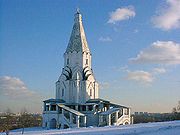 |
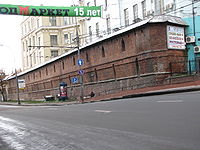 |
|
| Alexander Pomerantsev Alexander Pomerantsev Alexander Nikanorovich Pomerantsev was a Russian architect and educator responsible for some of the most ambitious architectural projects realized in Imperial Russia and Bulgaria at the turn of the 20th century... (1849–1918) |
||||
| Anatoly Polyansky (1928-1993) |
Q
| Portrait | Person | Notable works | ||
|---|---|---|---|---|
| Giacomo Quarenghi Giacomo Quarenghi Giacomo Quarenghi was the foremost and most prolific practitioner of Palladian architecture in Imperial Russia, particularly in Saint Petersburg.- Career in Italy :... (1744-1817) |
R
| Portrait | Person | Notable works | ||
|---|---|---|---|---|
| Bartolomeo Rastrelli Bartolomeo Rastrelli Francesco Bartolomeo Rastrelli was an Italian architect naturalized Russian. He developed an easily recognizable style of Late Baroque, both sumptuous and majestic... (1700–1771) |
||||
| Ivan Rerberg Ivan Rerberg Ivan Ivanovich Rerberg was a Russian civil engineer, architect and educator active in Moscow in 1897–1932. Rerberg's input to present-day Moscow include Kiyevsky Rail Terminal, Central Telegraph building and the Administration building of Moscow Kremlin... (1869–1932) |
||||
| Antonio Rinaldi (1710–1794) | ||||
| Ivan Ropet Ivan Ropet Ivan Petrovich Ropet was an architect widely regarded as the originator of the Russian Revival in architecture, which is sometimes called the Ropet Style after him... (1845–1908) |
||||
| Carlo Rossi Carlo Rossi (architect) Carlo di Giovanni Rossi, was an Italian architect, who worked the major portion of his life in Russia. He was the author of many classical buildings and architectural ensembles in Saint Petersburg and its environments... (1775–1849) |
||||
 |
Lev Rudnev Lev Rudnev Lev Vladimirovich Rudnev was a Soviet architect, and a leading practitioner of Stalinist architecture.-Biography:Rudnev was born to the family of a school teacher in the town of Opochka . He graduated from the Riga Realschule and entered the Imperial Academy of Arts in Saint Petersburg... (1885–1956)  Russian Empire Russian Empire Soviet Union Soviet UnionStalin Empire style architect |
Moscow State University Moscow State University Lomonosov Moscow State University , previously known as Lomonosov University or MSU , is the largest university in Russia. Founded in 1755, it also claims to be one of the oldest university in Russia and to have the tallest educational building in the world. Its current rector is Viktor Sadovnichiy... (1949–1953); Palace of Culture and Science in Warsaw Warsaw Warsaw is the capital and largest city of Poland. It is located on the Vistula River, roughly from the Baltic Sea and from the Carpathian Mountains. Its population in 2010 was estimated at 1,716,855 residents with a greater metropolitan area of 2,631,902 residents, making Warsaw the 10th most... , Poland Poland Poland , officially the Republic of Poland , is a country in Central Europe bordered by Germany to the west; the Czech Republic and Slovakia to the south; Ukraine, Belarus and Lithuania to the east; and the Baltic Sea and Kaliningrad Oblast, a Russian exclave, to the north... , (1952–1955); Latvian Academy of Sciences Latvian Academy of Sciences The Academy of Sciences is the official science academy of Latvia and is an association of the country's foremost scientists. The academy was founded as the Latvian SSR Academy of Sciences . It is located in Riga... , Riga Riga Riga is the capital and largest city of Latvia. With 702,891 inhabitants Riga is the largest city of the Baltic states, one of the largest cities in Northern Europe and home to more than one third of Latvia's population. The city is an important seaport and a major industrial, commercial,... , Latvia Latvia Latvia , officially the Republic of Latvia , is a country in the Baltic region of Northern Europe. It is bordered to the north by Estonia , to the south by Lithuania , to the east by the Russian Federation , to the southeast by Belarus and shares maritime borders to the west with Sweden... , (1953–1956). |
 |
|
| Marco Ruffo Marco Ruffo Marco Ruffo as known as Marco Fryazin was an Italian architect active in Moscow in the 15th century.... (15th century) |
S
| Portrait | Person | Notable works | ||
|---|---|---|---|---|
| Fyodor Schechtel Fyodor Schechtel Fyodor Osipovich Schechtel was a Russian architect, graphic artist and stage designer, the most influential and prolific master of Russian Art Nouveau and late Russian Revival.... (1859-1926) |
||||
| Vladimir Shchuko (1878–1939) |
||||
| Alexey Shchusev Alexey Shchusev Alexey Viktorovich Shchusev ), 1873, Chişinău—24 May 1949, Moscow) was an acclaimed Russian and Soviet architect whose works may be regarded as a bridge connecting Revivalist architecture of Imperial Russia with Stalin's Empire Style.... (1873-1949) |
||||
| Vladimir Osipovich Sherwood Vladimir Osipovich Sherwood Vladimir Osipovich Sherwood was a Russian architect who worked in Moscow. He was an Eclectics and Russian Revival practitioner, author of the State Historical Museum in Moscow. He was the son of Joseph Sherwood, an English engineer hired to build canals in Russia; the father died when Vladimir... (1832-1897) |
||||
| Vladimir Vladimirovich Sherwood Vladimir Vladimirovich Sherwood Vladimir Vladimirovich Sherwood , was a Russian architect who worked in Moscow in 1895-1914 in Art Nouveau style and modernized classics variant of Russian neoclassical revival that predated modernist architecture of 1920s.-Biography:... (1867-1930) |
||||
| Vladimir Shukhov Vladimir Shukhov Vladimir Grigoryevich Shukhov , was a Russian engineer-polymath, scientist and architect renowned for his pioneering works on new methods of analysis for structural engineering that led to breakthroughs in industrial design of world's first hyperboloid structures, lattice shell structures, tensile... (1853-1939) |
||||
| Pietro Antonio Solari Pietro Antonio Solari Pietro Antonio Solari , also known as Pyotr Fryazin, was a Swiss Italian architect.... (15th century) |
||||
| Ivan Starov Ivan Starov Ivan Yegorovich Starov was a Russian architect from St. Petersburg who devised the master plans for Yaroslavl, Voronezh, Pskov, Dnipropetrovsk, Mykolaiv, and many other towns in Russia and Ukraine... (1745–1808) |
||||
| Andrei Stackenschneider (1802-1865) |
||||
| Vasily Stasov Vasily Stasov Vasily Petrovich Stasov was a Russian architect.-Biography:Stasov was born in Moscow.... (1769–1848) |
||||
| Joseph Sunlight Joseph Sunlight Joseph Sunlight , was a Russian/ English architect whose energy amassed him a great fortune in Manchester and left at least one fine building in Sunlight House.... (1888-1978) |
||||
| Pavel Suzor Pavel Suzor Pavel Yulievich Suzor was a Russian architect, president of the Architects Society and count.Suzor graduated from the Saint Petersburg Imperial Academy of Arts in 1866. He started to work for the city council in 1873, and in 1883 he started to teach at the Saint Petersburg Institute of Civil... (1844–1919)  Russian Empire Russian Empireeclectics and Art Nouveau architect |
Over 80 apartment, baths and corporate buildings in St. Petersburg, including: Ushakov House, 1882–83; First Mutual Credit Society House, 1888–90; Singer House Singer House Singer House , also widely known as House of Books is a historical landmark building located at intersection of Nevsky Prospekt with Griboyedov Canal, just opposite to the Kazan Cathedral in Saint Petersburg, Russia... , 1902–04; |
 |
T
| Portrait | Person | Notable works | ||
|---|---|---|---|---|
| Vladimir Tatlin Vladimir Tatlin Vladimir Yevgrafovich Tatlin was a Russian and Soviet painter and architect. With Kazimir Malevich he was one of the two most important figures in the Russian avant-garde art movement of the 1920s, and he later became the most important artist in the Constructivist movement... (1885-1953) |
||||
| Konstantin Thon Konstantin Thon Konstantin Andreyevich Thon, also spelled Ton was an official architect of Imperial Russia during the reign of Nicholas I. His major works include the Cathedral of Christ the Saviour, the Grand Kremlin Palace and the Kremlin Armoury in Moscow.... (1794-1881) |
||||
| Domenico Trezzini Domenico Trezzini Domenico Trezzini was a Swiss Italian architect who elaborated the Petrine Baroque style of Russian architecture.Domenico was born in Astano, near Lugano, in the Italian-speaking Ticino . He probably studied in Rome... (1670–1734)  Switzerland SwitzerlandTsardom of Russia Tsardom of Russia The Tsardom of Russia was the name of the centralized Russian state from Ivan IV's assumption of the title of Tsar in 1547 till Peter the Great's foundation of the Russian Empire in 1721.From 1550 to 1700, Russia grew 35,000 km2 a year...  Russian Empire Russian Empire(Swiss Italian) Petrine Baroque architect |
Trezzini was the first chief architect of the newly founded Saint Petersburg Saint Petersburg Saint Petersburg is a city and a federal subject of Russia located on the Neva River at the head of the Gulf of Finland on the Baltic Sea... ; he designed the first general plan of St. Petersburg, as well as plans of Kronstadt Kronstadt Kronstadt , also spelled Kronshtadt, Cronstadt |crown]]" and Stadt for "city"); is a municipal town in Kronshtadtsky District of the federal city of St. Petersburg, Russia, located on Kotlin Island, west of Saint Petersburg proper near the head of the Gulf of Finland. Population: It is also... (1704) and the Alexander Nevsky Monastery (1717), and supervised a number of major projects: Peter and Paul Fortress Peter and Paul Fortress The Peter and Paul Fortress is the original citadel of St. Petersburg, Russia, founded by Peter the Great in 1703 and built to Domenico Trezzini's designs from 1706-1740.-History:... (since 1703), with the Peter and Paul Cathedral Peter and Paul Cathedral The Peter and Paul Cathedral is a Russian Orthodox cathedral located inside the Peter and Paul Fortress in St. Petersburg, Russia. It is the first and oldest landmark in St. Petersburg, built between 1712 and 1733 on Zayachy Island along the Neva River. Both the cathedral and the fortress were... inside, 1712–33; Peter the Great's Summer Palace Summer Palace of Peter the Great The Summer Palace is a diminutive residence of Peter the Great that was built in 1710-14 in his new capital, St. Petersburg, on the bank of the Fontanka River, in what is now the Summer Garden. The design was by Domenico Trezzini... , 1710–11; Twelve Collegia Twelve Collegia The Twelve Collegia, or Twelve Colleges is the largest edifice from the Petrine era still extant in Saint Petersburg. It was designed by Domenico Trezzini and Theodor Schwertfeger and built from 1722 to 1744.- Description :... Building (now the main building of Saint Petersburg University), 1722-36. |
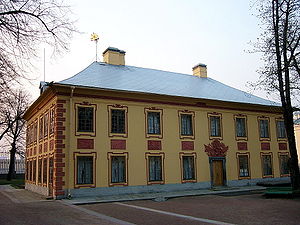 |
||
| Zurab Tsereteli Zurab Tsereteli Zurab Konstantines dze Tsereteli is a Georgian-Russian painter, sculptor and architect who holds the office of President of the Russian Academy of Arts.- Life :... (born 1934) |
||||
| Yevgraph Tyurin Yevgraph Tyurin Yefgraph Dmitrievich Tyurin was a Russian architect and art collector, famous as the builder of Elokhovo Cathedral in Moscow, the main cathedral of Russian Orthodox Church in 1945–2000, and Moscow State University expansion in 1830. Tyurin’s life and work, especially in his later years, was poorly... (1793-1873) |
U
| Portrait | Person | Notable works | ||
|---|---|---|---|---|
| Dmitry Ukhtomsky Dmitry Ukhtomsky Prince Dmitry Vasilyevich Ukhtomsky, Дмитрий Васильевич Ухтомский was the chief architect of Moscow, Russia during the reign of Empress Elizabeth.-Biography:... (1719–1774) |
V
| Portrait | Person | Notable works | ||
|---|---|---|---|---|
| Victor Vasnetsov (1848-1926) |
||||
| Alexander Vesnin Alexander Vesnin Alexander Aleksandrovic Vesnin , together with his brothers Leonid Aleksandrovic Vesnin and Viktor Aleksandrovic Vesnin he was a leading light of Constructivist architecture... (1883–1959) |
||||
| Leonid Vesnin Leonid Aleksandrovic Vesnin Leonid Aleksandrovic Vesnin , together with his brothers Aleksandr Aleksandrovic Vesnin and Viktor Aleksandrovic Vesnin he was a leading light of Constructivist architecture.... (1880-1933) |
||||
| Victor Vesnin Viktor Aleksandrovic Vesnin Viktor Aleksandrovich Vesnin , was a Russian Soviet architect. His early works follow the canon of Neoclassicist Revival; in 1920's, he and his brothers Leonid and Alexander emerged as leaders of Constructivist architecture, the Vesnin brothers... (1882-1950) |
||||
| Aleksandr Vitberg Aleksandr Vitberg Karl Magnus Vitberg was a Russian Neoclassical architect of Swedish stock.As a young man he was a member of Alexander Labzin's Masonic lodge, the "Dying Sphinx, studying Boehmist theosophy... (1787–1855) |
||||
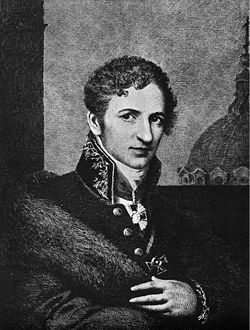 |
Andrey Voronikhin Andrey Voronikhin Andrey Nikiforovich Voronikhin was a Russian architect and painter. As a representative of classicism he was also one of the founders of the monumental Russian Empire style... (1759–1814)  Russian Empire Russian Empireneoclassical and Empire style architect and painter |
neoclassical interiors of Stroganov Palace Stroganov Palace The Stroganov Palace is a Late Baroque palace at the intersection of the Moika River and Nevsky Prospekt in Saint Petersburg, Russia. The palace was built to Bartolomeo Rastrelli's designs for Baron Sergei Grigoriyevich Stroganov in 1753-1754... , St. Petersburg, 1793; Voronikhin colonnades and Lion cascade in Petergof; Kazan Cathedral, St. Petersburg, 1801–11; Saint Petersburg Mining Institute Saint Petersburg Mining Institute The G. V. Plekhanov Saint Petersburg State Mining Institute and Technical University is Russia's oldest higher education institute devoted to engineering... , 1806-11. |
 |
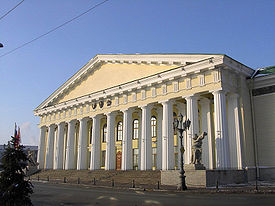 |
| Mikhail Vrubel Mikhail Vrubel Mikhail Aleksandrovich Vrubel is usually regarded amongst the Russian painters of the Symbolist movement. In reality, he deliberately stood aloof from contemporary art trends, so that the origin of his unusual manner should be sought in Late Byzantine and Early Renaissance painting.-Early... (1856-1910) |
Y
| Portrait | Person | Notable works | ||
|---|---|---|---|---|
| Postnik Yakovlev Postnik Yakovlev Postnik Yakovlev , is most famous as the architect and builder of Saint Basil's Cathedral on Red Square in Moscow... (16th century) Grand Duchy of Moscow Grand Duchy of Moscow The Grand Duchy of Moscow or Grand Principality of Moscow, also known in English simply as Muscovy , was a late medieval Rus' principality centered on Moscow, and the predecessor state of the early modern Tsardom of Russia.... Tsardom of Russia Tsardom of Russia The Tsardom of Russia was the name of the centralized Russian state from Ivan IV's assumption of the title of Tsar in 1547 till Peter the Great's foundation of the Russian Empire in 1721.From 1550 to 1700, Russia grew 35,000 km2 a year... tented-roof architect and fortification engineer |
Saint Basil's Cathedral Saint Basil's Cathedral The Cathedral of the Protection of Most Holy Theotokos on the Moat , popularly known as Saint Basil's Cathedral , is a Russian Orthodox church erected on the Red Square in Moscow in 1555–61. Built on the order of Ivan the Terrible to commemorate the capture of Kazan and Astrakhan, it marks the... on Red Square Red Square Red Square is a city square in Moscow, Russia. The square separates the Kremlin, the former royal citadel and currently the official residence of the President of Russia, from a historic merchant quarter known as Kitai-gorod... in Moscow Moscow Moscow is the capital, the most populous city, and the most populous federal subject of Russia. The city is a major political, economic, cultural, scientific, religious, financial, educational, and transportation centre of Russia and the continent... , 1555–60; with Ivan ShirIai designed the walls of the Kazan Kremlin Kazan Kremlin The Kazan Kremlin is the chief historic citadel of Tatarstan, situated in the city of Kazan. It was built on behest of Ivan the Terrible on the ruins of the former castle of Kazan khans... and, according to some sources, the Cathedral of the Assumption in Kazan Kazan Kazan is the capital and largest city of the Republic of Tatarstan, Russia. With a population of 1,143,546 , it is the eighth most populous city in Russia. Kazan lies at the confluence of the Volga and Kazanka Rivers in European Russia. In April 2009, the Russian Patent Office granted Kazan the... , 1561-62. |
.jpg) |
||
| Vasili Yermolin Vasili Yermolin Vasili Dmitriyevich Yermolin was a Russian architect and sculptor.Vasili Yermolin is known to have been a merchant, contractor, and head of an artel of the Muscovite builders. In 1462, he restored the old parts of the whitestone walls of the Moscow Kremlin from the Sviblov Tower to the... (15th century) |
Z
| Portrait | Person | Notable works | ||
|---|---|---|---|---|
| Andreyan Zakharov Andreyan Zakharov Andreyan Zakharov was a Russian architect and representative of the Empire style. His designs also alternated neoclassicism with eclecticism. He was born to a family that was employed by the Admiralty board, and his greatest work was his renovation and expansion of the Admiralty building... (1761–1811) |
||||
| Alexander Zelenko Alexander Zelenko Alexander Ustinovich Zelenko , 1871–1953, was a Russian and Soviet architect and educator, a pioneer in settlement movement and vocational education... (1871-1953) |
||||
| Mikhail Zemtsov Mikhail Zemtsov Mikhail Grigorievich Zemtsov was a Russian architect who practiced a sober, restrained Petrine Baroque style, which he learned from his peer Domenico Tresini... (1688–1743) Tsardom of Russia Tsardom of Russia The Tsardom of Russia was the name of the centralized Russian state from Ivan IV's assumption of the title of Tsar in 1547 till Peter the Great's foundation of the Russian Empire in 1721.From 1550 to 1700, Russia grew 35,000 km2 a year...  Russian Empire Russian EmpirePetrine Baroque architect |
participated in designing the Summer Garden Summer Garden The Summer Garden occupies an island between the Fontanka, Moika, and the Swan Canal in Saint Petersburg and shares its name with the adjacent Summer Palace of Peter the Great.-Original:... in St. Petersburg and the park in Petergof; completed the design of Catherinethal palace and park in Tallinn Tallinn Tallinn is the capital and largest city of Estonia. It occupies an area of with a population of 414,940. It is situated on the northern coast of the country, on the banks of the Gulf of Finland, south of Helsinki, east of Stockholm and west of Saint Petersburg. Tallinn's Old Town is in the list... 1718-25; The Church of Simon and Annа, Saint Petersburg Saint Petersburg Saint Petersburg is a city and a federal subject of Russia located on the Neva River at the head of the Gulf of Finland on the Baltic Sea... , 1734; |
|||
| Nikolay Zherikhov Nikolay Zherikhov Nikolay Ivanovich Zherikhov was a Russian Art Nouveau architect, active in Moscow in 1902–1914. A prolific author of apartment buildings financed by Broido, Wilner and Zaichenko real estate firms, Zherikhov stood out among contemporary architects for his use of decorative sculpture... (1870s-1916) |
||||
| Ivan Zholtovsky (1867–1959) |

